"A cosmic mystery of immense proportions, once seemingly on the verge of solution, has deepened and left astronomers and astrophysicists more baffled than ever. The crux ... is that the vast majority of the mass of the universe seems to be missing." -William J. Broad
Despite the wondrous, luminous sights of the night sky, we've learned that normal matter -- protons, neutrons, electrons and the like -- make up only 4% of the total energy in the Universe.
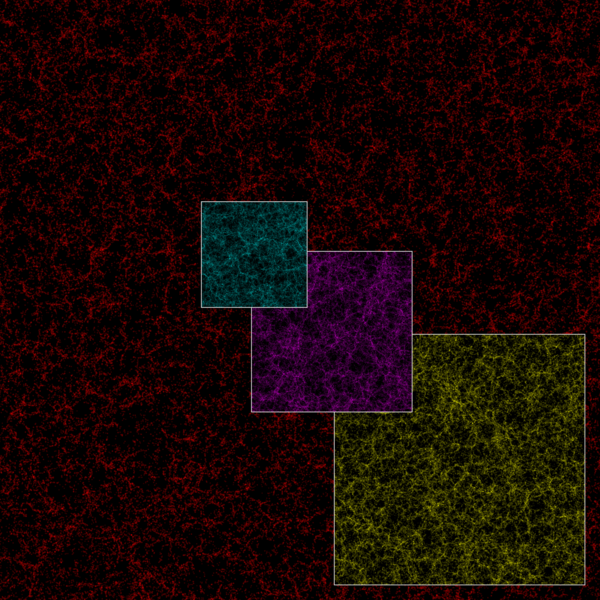
Image credit: Large Suite of Dark Matter Simulations (LasDamas) simulation; Vanderbilt.
The galaxies and clusters of galaxies lighting up the deepest recesses of space -- shining with stars -- are mostly composed of dark matter, a massive, clumpy type of matter that experiences gravity, but does not collide with normal matter, photons, or itself. They -- along with the entire fabric of the Universe -- also expand as though a mysterious, constant source of energy supplied a negative pressure to the Universe: that's known as dark energy.
And finally, despite the nuclei, atoms and light in the Universe all having their origins in the Big Bang, the Big Bang itself is not the beginning of the Universe, at least according to modern theory. That's reserved for cosmic inflation, the theory that tells how the Universe got to have the structure and temperature properties that it has today: by stretching quantum fluctuations across cosmological scales during a period of exponential expansion!
For many of you, this seems like a far-fetched story. After all, if you can't observe what happened before the Big Bang, and (as of yet) you can't directly detect this dark matter or this dark energy, you might be inclined to be skeptical of their existence. And I wouldn't blame you. But, I hope, you would encourage scientists to ask the question,
If these things are real, what new things would they predict that we could look for?
After all, that's what science is, and how science moves forward.
If we were to have a Universe that contained dark matter and dark energy in the proportions described above, and that had its origins consistent with the theory of cosmic inflation, we would expect there to be very, very specific patterns in the temperature fluctuations of the cosmic microwave background! This background is a left-over relic from the Big Bang, and comes to us (mostly) untouched from when the Universe was only 380,000 years old, when we formed neutral atoms for the first time!
Initially, we had matter and radiation uniformly distributed throughout the Universe, with fluctuations in temperature that didn't care about scale, at least, for the most part. What this means is that if we looked at all the 10-degree patches of sky, or all the 1-degree patches, or all the 0.1-degree patches, we would see the same types of temperature fluctuations. Some parts would be a few parts in 100,000 cooler, some parts would be a few parts in 100,000 warmer, and those temperature distributions would be independent of the size of our patches. But over time, matter tries to collapse, and radiation pressure bounces it apart again, much like ripples in a body of water. As a result, we end up with a pattern of fluctuations in the matter and radiation that only depend on parameters like the amount of dark matter and dark energy, and whether or not we had inflation.
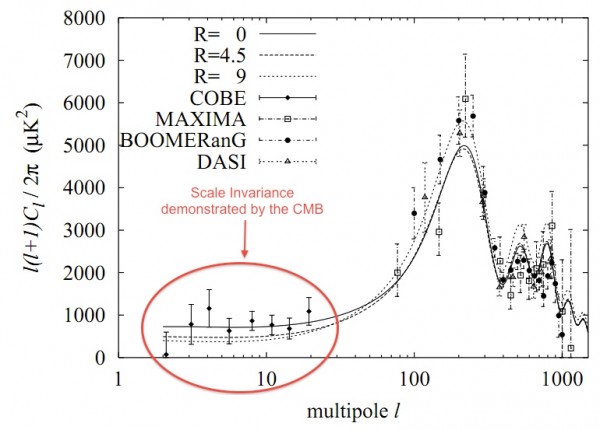
Image credit: Takeo Moroi & Tomo Takahashi, from http://arxiv.org/abs/hep-ph/0110096.
We got our first really good glimpse of this patter from the WMAP satellite, which basically confirmed this picture, above. The left-most part of the graph, the largest angular scales, have just about no tilt to them, which is what inflation almost predicts. Technically, the initial spectrum of fluctuations could be perfectly flat, given by a parameter known as the scalar spectral index (ns), which would equal 1. But practically all models of inflation predict that ns will be slightly less than 1, or somewhere between 0.92 and 0.98, depending on the model. This means there's a very, very slight slope to that line, something that we couldn't hope to measure until we reach multipoles well out past 1,000. This would be, needless to say, very difficult to measure, and would require measuring much smaller angular scales to much better accuracy than WMAP could on its own. Via WMAP, we were able to measure that the Universe was flat, that there was around 27% of the total energy in dark and normal matter combined, and that the other 73% was dark energy. There were some uncertainties, however, that required other observations to constrain them. The flatness part was easy; the differences between a flat Universe and non-flat cases were extreme.
But what goes on out past where WMAP can measure, at those very small angular scales? WMAP is no good at measuring that; we'd need a specialized mission for that. Luckily for us, the South Pole Telescope was designed especially for just such a task.
75 feet tall and 280 tons, the South Pole Telescope can measure the night sky -- weather permitting -- for six months at a time out of the year. At small angular scales, the cosmic microwave background will start to notice that there are galaxies and clusters in the way; the (slightly) warm gas in those objects will distort the temperature on top of the initial fluctuations and the ripples, and so we need to be prepared to detect them. But if we are, the Universe with a certain amount of dark matter and dark energy should make very specific predictions, and our brand new measurements had better line up. First off, here's the region of the sky that the South Pole Telescope measured, to a much greater precision and accuracy (by about an order of magnitude) than WMAP could.
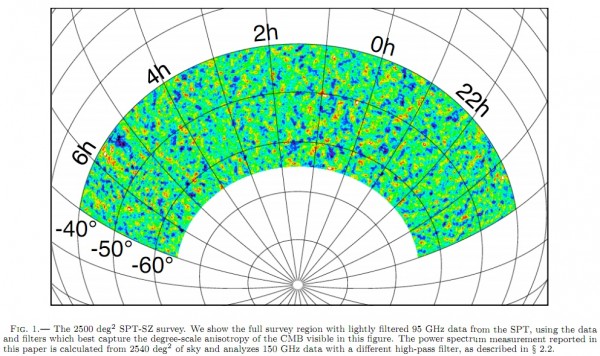
Image credit: K.T. Story et al., 2012, from http://arxiv.org/abs/1210.7231.
When they did their temperature analysis, they were able to measure a spectrum of temperature fluctuations, just like WMAP did. The only difference is, instead of measuring from multiple moment 2 through about 800, it measured from about 700 to about 3,000!
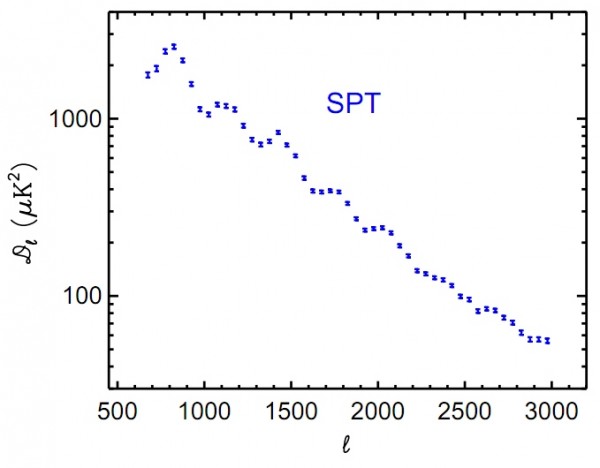
Image credit: K.T. Story et al., 2012, from http://arxiv.org/abs/1210.7231.
Now, what it expected to see was a very specific pattern of wiggles, dependent only on the amount of dark matter and dark energy present. Since the WMAP data already constrained those, the pattern was already pre-determined. Because we also know the physics behind how much the warm gas in galaxies and clusters should shift the temperature (the Sunyaev-Zel'dovich effect), we should see a very specific pattern of wiggles added to a very predictable, slow rise as we move farther out to larger and larger multipole moments.
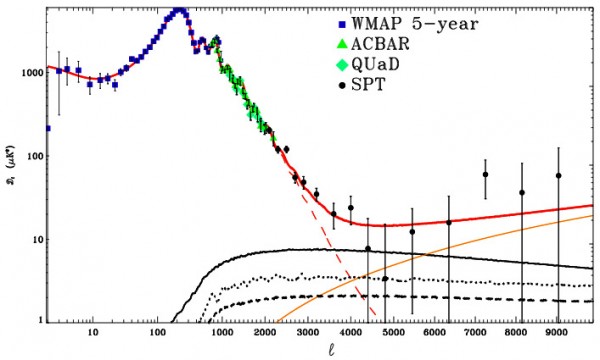
Image credit: The SPT Team / KICP, via http://kicp.uchicago.edu/.
So, enough with the suspense. Does the model work right? Did we see something consistent with what we expected? Let's go straight to the data, and see how well the data (in points, with error bars) fits the model that includes all contributions (solid line) and the model that doesn't include the Sunyaev-Zel'dovich effect (dashed line).
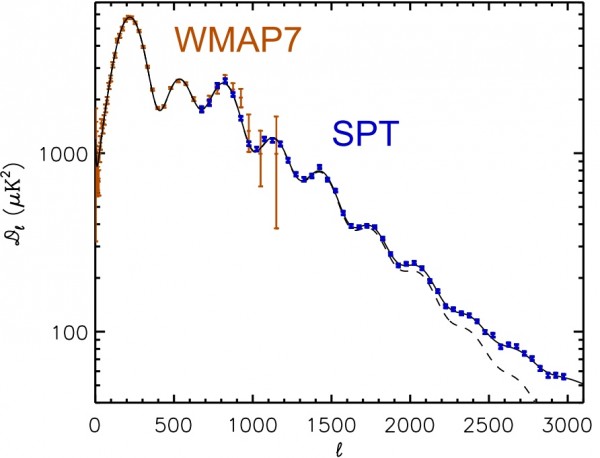
Image credit: K.T. Story et al., 2012, from http://arxiv.org/abs/1210.7231.
First off, look at those tiny error bars! And second off, look at how well they match that prediction! To a breathtaking degree, they confirm exactly what we expected to find: a Universe that was about 3/4 dark energy, about 1/4 dark + normal matter combined, and that was consistent with inflation. But there were two huge improvements that came out of this experiment, that I want to highlight for the entire world.
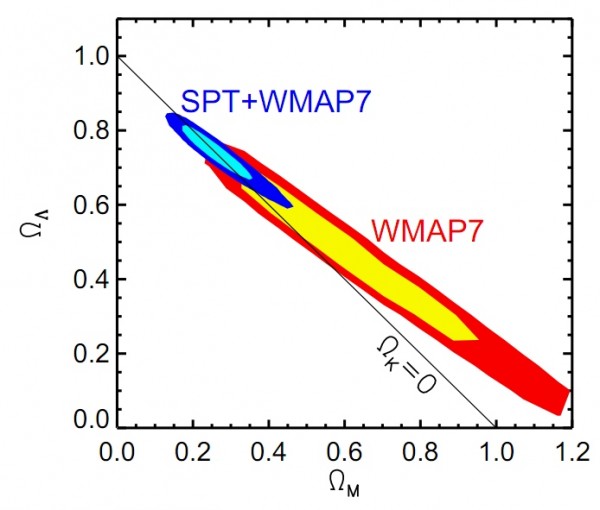
Image credit: K.T. Story et al., 2012, from http://arxiv.org/abs/1210.7231.
1.) The Universe is really, truly, very, awesomely flat! There is practically no spatial curvature, as constrained by the microwave background alone. No other measurements necessary. The WMAP data, on its own, had a fairly large degeneracy, but the addition of the South Pole Telescope data wipes that out, and tightly constrains what fraction of the Universe's energy is in the form of matter (x-axis, above) and what fraction is in the form of vacuum energy (y-axis). The flatness of the Universe is now known to a better precision than ever before, and we can now say that the curvature is -- with error bars -- -0.3% ± 1.4%, which is eminently consistent with no curvature at all. (And is a 20% stronger constraint than WMAP alone!) But this next one truly boggles the mind.
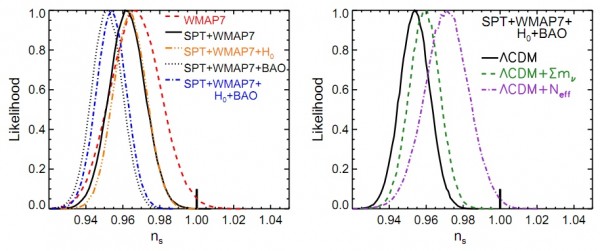
Image credit: K.T. Story et al., 2012, from http://arxiv.org/abs/1210.7231.
2.) The scalar spectral index, ns, is very well measured to be less than 1! When you add in the newly-measured South Pole Telescope data, we find that ns = 0.9623 ± 0.0097, which is the strongest evidence yet for inflation based on the scalar spectral index! This might not sound as exciting to you as it is to me, so let me phrase it in slightly different terms:
We just made a measurement that provides the strongest evidence ever that inflation came before the Big Bang, and what we measured is consistent with our best models for what inflation might be!
That's why I'm excited, and you should be, too! Go and read the preprint for yourself, here, if you like, and have the happiest of all Halloweens with the newly-confirmed 96% dark, inflationary Universe!
- Log in to post comments

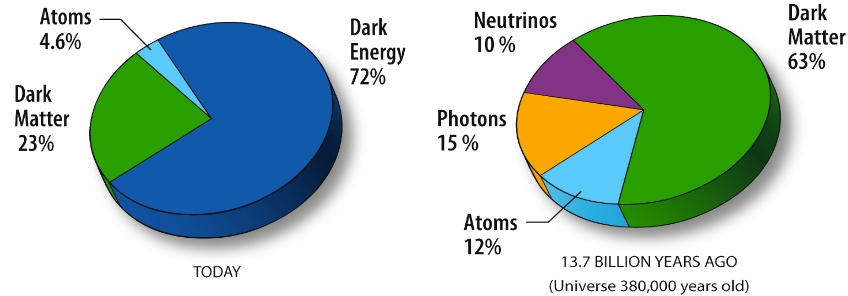
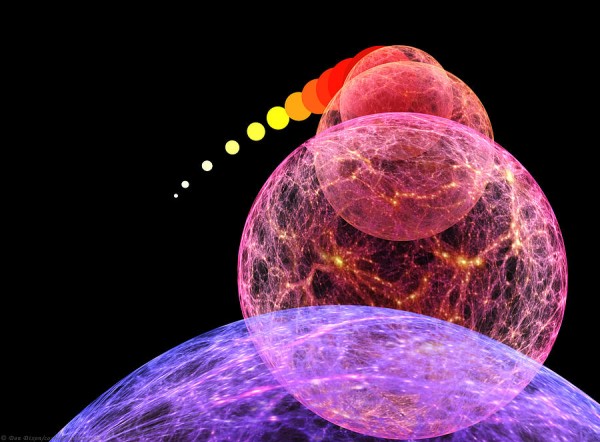
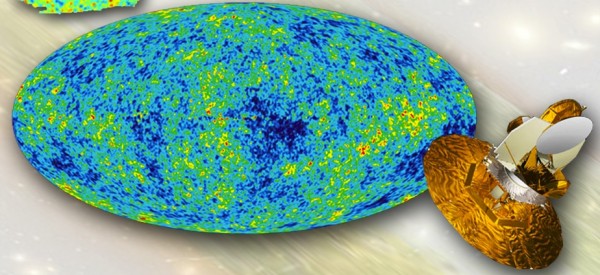
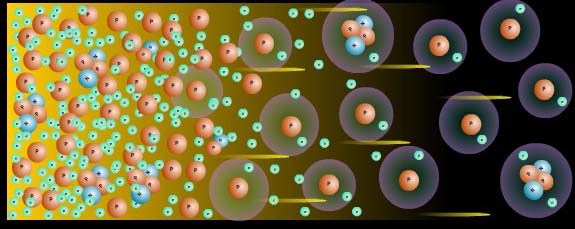
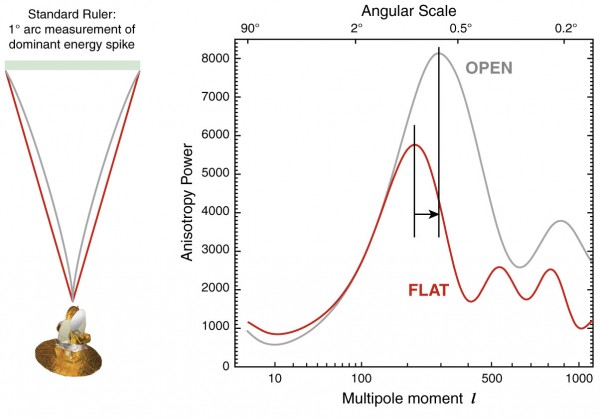
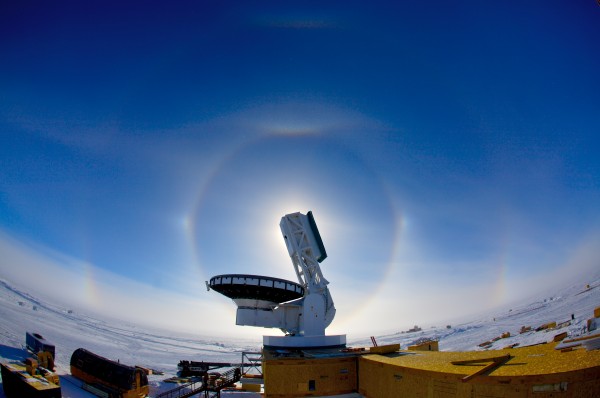




Amazing post. Thanks.
Once again Ethan, you have done an excellent summary of some really important research. I've had to reread this post twice to get it. thanks.
This science is really excellent; but once again, I must admit my ignorance. So I will plow through the research paper and google and links to get a better understanding. And I'll reread this post again.
Ethan, I appreciate especially when you present current research that forces me to work harder to understand why it's important. Thanks.
This particular research really shows nicely the interplay between experiment/observation and theory. It's a very positive learning cycle theory suggesting observations, observations validating theory, etc, etc. right down to a very detailed and precise explanation. It squeezes the skepticism in my mind, my reasons screams, "OK there really is very little (or no) room left for skepticism; we really have evidence for something before the big bang. Very nice excellent science. So let me just try very hard to understand this very clear thinking."
If the Universe is flat does that rule out the 'Bubble' Multiverse ideas?
Or does the flatness only mean that the whole place is much, much bigger and we haven't reached a curved area yet?
@ Norma Parfitt:
It means that if the universe isn't actually perfectly flat, then the distances at which this not-perfect-flatness becomes noticeable are way, WAY outside the observable universe.
And with the universe expanding as it is, we will never reach it either.
Here's an old post from Ethan's blog where based on the WMAP data he says that the universe must be at least 150 times the size of the observable universe. This data would seem to suggest the minimum size is much more than that.
http://scienceblogs.com/startswithabang/2012/07/18/how-big-is-the-entir…
Sorry, I meant to say the radius of curvature is at least 150 times the size of the observable universe, so the universe we can see is an even tinier fraction of the total 'surface'.
nice answer and side bar info CB. And I'm with OKThen. Def will need a re-read to mentally digest a little better.
A few years ago (thanks to bad flight weather) I had the good fortune to take an opportunity to visit the SPT in person, and chat with some of the grad students working on it. It was incredibly nice of them to share their time explaining its purpose to some unexpected laypersons.
Can someone please explain to me, though, the scalar spectral index and its relationship to inflation?
Those things too far apart haven't had the time to equalise (as in "notice each other were there, at a different state and mixed the energy about to near equilibrium"). The bigger the difference and the larger apart those differences are, the longer it takes for that to equalise.
For the universe to appear now as if it were as flat as it is seen to be, under the assumption that there was no special state at the time (e.g. already very very even), what we see can only have been a small part of the original, which had enough time and small enough difference to equalise.
Which means that the rest of the universe must have run off out of sight.
Inflation.
Wow: Thanks, but that's not quite what I'm asking. Firstly, I don't understand generally how one calculates n sub s, the scalar spectral index (i.e. in regards to equation 26 in the preprint). I mean, I googled the equation to solve for ns, but the equation is so abstract to me that I need a qualitative description to understand how ns comes from the pretty picture that the SPT took.
Secondly, I don't understand the primordial power spectrum function very well, "P sub s (k)". I can vaguely appreciate that if ns = 1, it would imply scale-independent perturbations. But I can't intuitively grasp what happens when the scalar index deviates one way or another from unity. I don't get why a scalar index < 1 implies inflation happened "before" the big bang. In fact the typical explanation I've gotten from cosmologists is that the big bang "definitely" came first, then inflation happened extremely soon thereafter.
I've read in Ethan's other posts, some cursory descriptions of the scalar spectral index, and its relationship to inflation, but I'd really like to understand it more deeply. Because It seemed like the punchline to his current post.
Mac,
I don't know how technical of an explanation you can handle, so here we go.
The slope of the inflationary potential is strongly related to the scalar spectral index, n_s. If the potential were completely flat (horizontal), you'd get n_s = 1, because the fluctuations would be the same on large scales as on small scales.
However, slight deviations in both the first and second derivative of the potential will cause slight deviations from n_s = 1. Some classes of deviation -- such as potentials shaped like double-wells (i.e., Coleman-Weinberg) and potentials shaped like parabolas (as in Linde's chaotic inflation) -- result in n_s slightly smaller than 1. If n_s were exactly equal to 1, that would be equivalent to a completely flat potential, and hence inflation would never end.
So it needs to be near one, but not quite equal to it. And it's amazing that we measure that in a statistically significant way.
If you are at least a 3rd year physics graduate student, I can give you a more sophisticated explanation, or refer you to Dodelson's modern cosmology, which has a strong treatment of the issue.
Thank you, I will (attempt to) look into Dodelson next!
It boils down to "They just don't know" and they are getting upset over something they haven't control over.
Is fascinating though.
Garbage is more like it. 99.999% of the universe is Plasma state of matter which can be mapped. Cosmological Redshift is the Wolf Shift found in 1987. Thanks for nothing and wasting money on outdated models boys.
I remember in sience class whenever the instructor would say "nothing is faster than the speed of light.' I would disagree and reply there is something VASTLY faster than the speed of light-and that is DARKNESS. I still got an "A" in the class even though I was called a looney.
@ Jack
next time you want to post about Plasma Cosmology, please do that here:
http://scienceblogs.com/startswithabang/2012/09/23/weekend-diversion-yo…
if you have concrete and specific remarks about CMB and the above article and measurement, then write that. But hijacking the thread and going into other, often fringe, theories is not allowed.
Here's my problem with understanding. I'm not disputing anything. I'm just not getting something.
"We just made a measurement that provides the strongest evidence ever that inflation came before the Big Bang, and what we measured is consistent with our best models for what inflation might be!" Very nice. but???
Cosmic inflation seems to be that "Inflationary epoch of
Unknown duration, ending 10–32(?) seconds after the Big Bang" wikipedia; but now we put Cosmic inflation before the big bang. OK but what does that mean?
So, it seems that the observed universe's expansion is accelerating, i.e. dark energy or in Alan guth's words "eternal inflation".
So we now have inflation of some sort for the entire history and prehistory of the universe. the only difference being that the inflation at the beginning a very rapid doubling of the size of the universe while the current inflation is a very modest doubling of the size of the universe. I think this is right so far. Correct me please if I've got it wrong.
In summary, Ethan says, "cosmic inflation.. tells how the Universe got to have the structure and temperature properties that it has today: by stretching quantum fluctuations across cosmological scales during a period of exponential expansion!"
OK. But what exactly is left of the big bang idea????
Ethan says, "the nuclei, atoms and light in the Universe all having their origins in the Big Bang"
That's nice but; that's a bit like saying Santa Claus put the nuclei, atoms, and light (and all of the antimatter) in an already existing and inflating universe. And then the universe went through all of its usually evolution. http://en.wikipedia.org/wiki/Chronology_of_the_universe (except that the Inflationary epoch has been moved to the beginning of the chronology o f the universe and not after the Planck epoch, grand unification epoch, and the electroweak epoch.
So what exactly is left of the big bang theory. Now there is an inflating universe without "nuclei, atoms and light in the Universe" and now BANG "nuclei, atoms and light ARE in the Universe "
Of course all of the steps in the chronology listed in wikipedia are still there except for the Santa Claus step in which "nuclei, atoms and light are placed under the Christmas tree that we all our visible universe."
My problem is that we seemed to be left with a theory of the Big Bang in which the only purpose of the Big Bang is to put presents under a Christmas tree.
Which is fine. I have no problem just saying, "We don't know how nuclei, atoms and light came to be in in the Universe." Logically such a statement seems no different than "the nuclei, atoms and light in the Universe all have their origins in the Big Bang"
As I recall Big Bang implied a time of a generalrelativistic singularity; but now there is no such singularity. So we can replace the name "big bang", with "tooth fairy", "santa claus", "god" or any other name "Pandora".
But I just prefer the scientifically correct idea that "We don't know how nuclei, atoms and light (and antimatter) came to be in in the Universe."
Now let's listen to Alan Guth video Here is Alan Guth explaining Cosmic Inflation https://www.youtube.com/watch?v=HwCCMHH378Q at 2 minutes 40 seconds to 2 minutes and 50 seconds. "It's called the big bang; but in spite of that name, it never really was a theory of a big bang. From the very beginning, as far as its scientific formulation, the big bang theory was really just a description of an aftermath of a bang.
The theory says nothing whatever about what banged, why it banged, or what happened before it banged. So inflation is actually an attempt to try to answer some of those questions."
We still know that the observable universe includes all human observations some of events as old as 13.7 billion years. And now we are hypothesizing events before 13.7 billion years old. But we got no BANG, we just got some I DON"T KNOWS.
Please correct me if I misunderstand Alan Guth or have misquoted him. Please correct me if I am completely or partially muddle headed.
In sum, the BANG of the big bang seemed to require a general relativity singularity event 13.7 yrs ago. And the idea of such an event has been in trouble for as long as there has been quantum mechanics. But now this work seeems to definitively say that there was something (logically/observationally/theoretically necessary) before such a singularity event. So in my mind, nothing is left of the general relativity singularity efent except to say " "We don't know how nuclei, atoms and light (and antimatter) came to be in in the Universe." But the emergence of "nuclei, atoms and light (and antimatter) in our visible universe" doesn't have anything to do with general relativity.
Oops wait a minute, I've just listened to Alan Guth again starting at 3 minutes, "Another important question is where the matter in the universe comes from. In the conventional big bang theory, without inflation, all of the matter was assumed to be present from the very beginning. For every particle that exists in the universe today, it was assumed that there was at least a precursor particle that existed from the beginning with no explanation of where all that matter came from. Inflation actually offers a possible explanation for the origin of essentially all of the matter in the universe.... once gravitational repulsion (inflation) started... we need about a hundred doublings to create the universe... an important and very strange feature of exponential expansion driven by this gravity is that while it's taking place the density of matter does not go down... the density of matter actually remains constant."
OK that's enough. Look at that, Alan Guth just got rid of the Santa Claus reason to keep the phrase "Big Bang". It is a nice title, it is an historical term, it has sentimental value;' but the phrase "big bang" is devoid of scientific meaning other than as an umbrella idea that says, the universe is expanding.
OK, I admit it; I've convince my self (with Alan guth's help).
Do I get it or do I not get it? That is the question!!
@ OKthen
You are correct that there are numerous sources have a different notion of what is Big Bang and what was first.
If you define Bing Bang as begging of "anything" then inflation clearly goes after it. But if you define big bang as begining of "matter/radiation" universe (you know.. very hot, quark/guon soup) then inflation happened before it.
Here is the quote from another site, which sums it up pretty nicely:
"In the Inflation model, our Universe starts out as a rapidly expanding bubble of pure vacuum energy, with no matter or radiation. After a period of rapid expansion, or inflation, and rapid cooling, the potential energy in the vacuum is converted through particle physics processes into the kinetic energy of matter and radiation. The Universe heats up again and we get the standard Big Bang."
p.s.
sorry.. " Bing Bang as begging of..." should be: beginning instead of begging.
"We just made a measurement that provides the strongest evidence ever that inflation came before the Big Bang..."
So, does this mean that you'll be renaming your blog?
Sinisa
The trouble is we don't get the standard big bang because as Alan Guth says, " In the conventional big bang theory, without inflation, all of the matter was assumed to be present from the very beginning... with no explanation of where all that matter came from. Inflation actually offers a possible explanation for the origin of essentially all of the matter in the universe…. an important and very strange feature of exponential expansion driven by this gravity (i.e. inflation) is that while it’s taking place the density of matter... actually remains constant.” This is the key.
In other words, as the universe continues to inflate even now "the density of matter... actually remains constant.” Which means that there will be more matter in the visible universe tomorrow or a billion years from now than there is today. This is very different than standard big bang theory.
Assuming that I am understanding Guth correctly. I've got to go through his video part 1 that I linked to and part 2 (total of about 18 minutes) a couple of times.
No more "standard" big bang; but we still have most of the chronology aws outlined in wikipedia link.
"with no explanation of where all that matter came from"
We don't know that an explanation is needed.
E=mc2
gravitational potential energy is negative. Mass is positive.
Inflation doesn't answer where the matter comes from but why it isn't either all clumped to nothing already or still in a diffuse gas.
The longer inflation went on for, the longer it takes for stars to forwhen it stops.
I believe you also have the mass of the universe wrong. If there were no expansion of space and rather the universe was closed (or nearly closed), then the acceleration of space is slowed down by the gravitational attraction of all the matter in it. And so what USED to be beyond the light curve now retreats less fast than light leaving it gets to us. And so it becomes part of the observable universe.
But in an accelerating expansion, the light curve doesn't keep up with the matter and it drops out of the observable universe.
Yes Alan Guth says, "the idea is that the energy of a gravitational field is actually negative so what happens during inflation, so as the tremendous exponential expansion is going on with a constant density of matter more and more positive energy is appearing in the form of this tremendously increasing amount of matter but at the same time more and more negative energy is appearing in the form of the gravitational field which is filling this region so the total energy including the positive contribution from the matter and the negative contribution from the gravity is at all times very small. It could in fact be exactly zero... the universe today appears to be undergoing a very slow form of inflation."
Guth also says, "the primordial soup (at the end of primordial inflation)... ends up having exactly the properties that had been assumed for the conventional big bang theory. So one of the beauties of the inflationary theory is that it did not require anybody to give up anything about what we previously thought about cosmology. Inflation just very naturally sets up what had been previously assumed as the initial conditions of the conventional big bang theory." That's Alan Guth's words, not mine.
I can't see any value except sentiment for keeping the term "big bang". Alan Guth is very diplomatic in referring to "conventional cosmology", i.e. "in conventional cosmology without inflation.".
But seriously, what exactly is the value and the meaning of the term "big bang"???
@OKthen
there is no value. It's just a word, a term we use to describe a set of events. yes, the 60's version of it is incorrect. But it's just a word. :) You can call it whatever you want as long as we talk about same processes that happened.
Why is narrow gauge the size it is in the UK?
Roman donkey trains.
It's pretty descriptive and catchy and, like "the greenhouse effect" gives you a vague idea of what is going on.
And, like the greenhouse effect, doesn't mean in science what the layman thinks it is (there's no glass ceiling on the earth nor is there one in the corporate headquaters.
Sinisa Lazarek
"You can call it whatever you want as long as we talk about same processes that happened."
The problem is that, as I understand, "inflationary cosmology" is very different than "conventional big bang cosmology".
Let me repeat.
Alan Guth at 3 minutes says, “Another important question is where the matter in the universe comes from. In the conventional big bang theory, without inflation, all of the matter was assumed to be present from the very beginning. For every particle that exists in the universe today, it was assumed that there was at least a precursor particle that existed from the beginning with no explanation of where all that matter came from. Inflation actually offers a possible explanation for the origin of essentially all of the matter in the universe…. once gravitational repulsion (inflation) started… we need about a hundred doublings to create the universe… AN IMPORTANT AND VERY STRANGE FEATURE OF EXPONETIAL EXPANSION BY THIS GRAVITY (i.e. inflation) IS THAT WHILE IT'S TAKING PLACE THE DENSITY OF MATTER DOES NOT GO DOWN... THE DENSITY OF MATTER ACTUALLY REMAINS CONSTANT.”
Now, if I accept inflation in the beginning (13.7 bil years ago) of our universe (very rapid inflation) and if I accept inflation NOW in our universe (very slow inflation); then both the past of the big bang theory changes, the present, AND the future of the big bang theory changes.
The present is that there are at least 3 cosmological observations that can't be explained by the "conventional big bang cosmology" that can be explained by "inflationary cosmology".
If I accept that under the inflation "THE DENSITY OF MATTER ACTUALLY REMAINS CONSTANT"; then after 100 billion years from now of slow inflation the density of matter in our visible universe will also remain approximately the same.
However, this is quite different than what Ethan said in a recent post.
"100 billion years into the future, when the Universe is many times its current age... Instead of clusters and superclusters of galaxies, there will be… nothing. Dark energy will take care of that, driving all the other galaxies in the Universe, everything that isn’t bound to our local group, our beyond our visible horizon. If we were born on a habitable planet 100 billion years from now, we’d conclude we were the only galaxy in the Universe."
But wait a minute, inflation is continually creating new matter (matter having positive energy) and (inflation having negative energy); thus no NET energy increase in the universe.
And all of those new little particles created by inflation (I assume by some kind of Unruh effect) will have plenty of time to coallecse into more stars and galaxies and superclusters. I mean it took only 13.7 billion year to reach NOW with stars, galaxies and superclusters; so 100 billion years is no problem.
So accepting inflationary cosmology changes the future of big bang cosmology SIGNIFICANTLY.
This is a BIG DIFFERENCE difference!!
So inflationary cosmology does predict a very differenct FUTURE of the universe. UNLESS, you tell me that INFLATION of the past (before 13.7 years ago) KEPT THE DENSITY OF MATTER CONSTANT; but the inflation of the future 100 billion years WILL NOT KEEP THE DENSITY OF MATTER CONSTANT.
So does inflation keep the density of matter constant or not. And if you want to have it both ways; please explain why in a credible way.
So that is one of my problems with keeping the term "big bang cosmology"; it has baggage like predictions of the future that are wrong. It assumes that dark energy is different than inflation; i.e. that dark energy expands without keeping the density of matter constant, while inflation expands with keeping the density of matter constant.
At least this is my understanding.
I got no problem with being wrong.
Just give me a reasonable explanation. But it seems to me that "inflationary cosmology" is really very different from "conventional big bang cosmology."
OKThen,
When Guth says that in the video, he is explicitly not talking about conventional matter, he is talking about a hypothetical (and very speculative) type of matter that is responsible for inflation.
I'm not entirely sure why he does this, as it isn't necessary, but we neither believe nor observe that such a particle is responsible for our present inflationary / dark energy state.
Inflation requires a field, and during inflation the field energy density is the thing that remains constant; normal (and dark) matter gets diluted during exponential expansion the same way you'd expect it to. Guth was, at best, imprecise with the language he used in that video.
"If I accept that under the inflation “THE DENSITY OF MATTER ACTUALLY REMAINS CONSTANT”"
If Ethan is correct about Guth's (mis)use of matter in his video (I haven't seen it), then that's the source of your problems here.
It's pretty unclear whether it is talking SOLELY in inflation terms too.
But if you were talking about ordinary baryonic matter during inflation it DOESN'T remain constant in density. It drops. There's more space for the matter to be in.
After inflation, gravity is taking over and stuff coalesces, so baryonic matter density doesn't stay constant then either.
If you're taking someone else's word for it and doing so results in a counterfactual result, either
a) you didn't understand the statement
or
b) the statement is wrong
Ethan
I've checked Alan Guth's papers arXiv and I find similar statements but nothing that better clarifies (to me at least) his meaning.
"energy density is the thing that remains constant". OK sort of; but of course E = mc^2. So the question begs... to be clarified.
I'll keep paying particular attention to try to better understand the relationship between inflation and matter density.
But if Ethan or Wow say that Guth mispoke and I misinterpreted; I accept that.
So yes... oh well; any further clarification would be appreciated.
Except that E=mc2 doesn't mean matter is energy.
It means they are interchangeable in a reaction.
Imagine if you will a sheet of some weird material being stretched. The mechanism of that stretch means that by stretching, energy is put in to the fabric at a rate that keeps the potential energy of the bonds increasing at the same rate as the square of the distance of the connections' lengths.
Then the energy density of the fabric would remain constant per unit area.
But the density per unit area still goes down. And any connection slightly more loose (i.e. closer together) is stretched more easily and therefore loses its areal density more quickly than another area which had already been stressed (less areal density).
Therefore material density would become more uniform, but STILL reduce.
Wow
Thanks for the explanation. Certainly a weird material. I need to think upon it. Not an idea I would think of; but hey, why not?
Not to argue; can you give me a reaction to this longer Alan Guth quote that seems (to me) to suggest that he is talking about standard model particles?
Eternal inflation and its implications, 2007, Alan H. Guth http://arxiv.org/pdf/hep-th/0702178v1.pdf, pg 2
Complete Section i of Introduction (i.e. no deletions)
"The universe is big. First of all, we know that the universe is incredibly large: the visible part of the universe contains about 10^90 particles. Since we have all grown up in a large universe, it is easy to take this fact for granted: of course the universe is big, it’s the whole universe! In “standard” FRW cosmology, without inflation, one simply postulates that about 10^90 or more particles were here from the start. However, in the context of present-day cosmology, many of us hope that even the creation of the universe can be described in scientific terms. Thus, we are led to at least think about a theory that might explain how the universe got to be so big. Whatever that theory is, it has to somehow explain the number of particles, 10^90 or more. However, it is hard to imagine such a number arising from a calculation in which the input consists only of geometrical quantities, quantities associated with simple dynamics, and factors of 2 or π. The easiest way by far to get a huge number, with only modest numbers as input, is for the calculation to involve an exponential. The exponential expansion of inflation reduces the problem of explaining 10^90 particles to the problem of explaining 60 or 70 e-foldings of inflation. In fact, it is easy to construct underlying particle theories that will give far more than 70 e-foldings of inflation. Inflationary cosmology therefore suggests that, even though the observed universe is incredibly large, it is only an infinitesimal fraction of the entire universe."
It seems to me that those 10^90 particles are the leptons and quarks, photons and gluons of the standard model; not weird matter.
By the way folks reading this. I defer to Wow and Ethan's opinion because they are professional astronomers. All I've got is a few paragraphs of Guth's words that try to explain the meaning of very complicated mathematics. So I defer to professionals interpretation.
Yes, I ask my toughest questions. But if I don't like their answer; then I have to accept that my hunch is incorrect (i.e. very wild speculation until someone proves otherwise to the community of professional astronomers) or I have to join the ranks of the true believer in psuedoscientists (not I).
So, I choose to try to understand current theory, ask my best questions, iterate again, etc..; but accept observation and best theoretical interpretation for what it is, the best currently understood science.
Here, I'm trying to understand the published "inflationary cosmology" as understood by professional astronomers!!
OK, thanks for any thoughts Wow or Ethan on this longer Guth quote.
"Thanks for the explanation. Certainly a weird material. I need to think upon it."
I wasn't saying that this is what "The Big Bang" is made from, OKThen, it was an explanation of how physically you can get energy density retained at an even value when you're losing matter density (and possibly ripples in that matter density).
Nothing more than that.
An analogy for the "Energy density remains constant during inflation".
Inflation itself may have sourced its energy from the decoupling of the five forces of nature as the universe expanded. Or maybe the collapse of the other 6 or 21 dimensions to ineffability. Or maybe the energy of rebound in the brane collision.
Depending on the model you are testing as a candidate for how the universe started...
So that material has nothing to do with inflation. Solely an illustration of how getting energy density mixed up with matter density can source an incorrect conclusion.
"without inflation, one simply postulates that about 10^90 or more particles were here from the start"
OK, here I'd call rubbish.
No, one simply postulates that those 10^90 (IIRC much nearer 10^81, but what the hey) particles were just nearly perfectly smooth.
****YOU DO NOT**** have to postulate they were all there.
There may have been 10^10,000 virtual particles at any one time being created and destroyed in wild abandon there in the very early attosecond of the universe without inflation. And as it cooled, the virtual particle energies would drop and most would disappear never to return (because never would the universe get that energy dense). Leaving 10^90 freezing out of the virtual soup when matter and radiation decoupled.
Inflation explains better two things about the universe than noninflationary universe theories, but why there is 10^90 (or 80 or whatever) particles in the known universe isn't one of them.
Inflation can explain
1) why the universe that has no reason to be so uniform IS so uniform (because we're only in a very small part of that uniform univers. A very similar effect is used to make newtonian scopes more accurate: you block off the aperture and your image is now based on a smaller section of the mirror which, by random chance, will have some areas with more *accurately appropriate* curvature to create the image than the entire surface can manage).
b) Why there are matter particles. If inflation separated a virtual pair, then the pair would not collide and return to the field. See Hawkin Radiation. Simple binomial counting stats means that you could expect some area of a larger structure containing 10^180 virtual particle pairs to have, by purely random and undirected reasons, retain an imbalance of positive to negative partners at around the 10^90 particle level.
Admittedly that one doesn't work if your separation is in the same 3D space as the matter and their connection. You'd need expansion in more than the 3D space to do that as efficiently as that.
But if the uberuniverse had 10^10,000 particles in it, it's practically certain that separation in one small area would get it "right enough" no matter how the inflation happens.
NOTE: the above is just an example. Different models explain the situation differently.
Whether they explain it correctly and without needing more special pleading than another theory is why some go out of fashion (like the rebounding universes one).
Note too: without inflation, you can get that 10^whatever particles remain merely by having matter/anti-matter *not quite* symmetrical.
Without inflation, it becomes another fine tuned parameter of our universe, requiring some anthropic principle to explain away.
Wow
That's what I needed, someone to put the complexity of our universe and the complexity of various competing hypotheses about our universe back into Guth's simple words.
Thank you for putting Guth in perspective. Nice explanations.
"We just made a measurement that provides the strongest evidence ever that inflation came before the Big Bang, and what we measured is consistent with our best models for what inflation might be!"
Ethan, always like your presentations, graphics, organization and much info that I find here :)
Concerning this thread, I do not think there is any evidence that I know of for Inflation theory in the first place without the assumption of a Big-Bang-like beginning. Next the Big Bang model itself has often been considered a failed theory without the Inflation hypothesis. Both theories are needed to mutually support each other.
The microwave background is thought to be support for the Big Bang model, but that supposed evidence can also be otherwise explained/ interpreted so such ideas as the Inflation era came before the Big Bang, I think, at the very best should be considered speculative and a weak hypothesis.
That the observable universe seems completely flat could be considered evidence against General Relativity and the mathematical basis for the Big Bang model (BB). The ideas of dark matter, dark energy, and Inflation all could be considered ad hoc hypothesis needed to “save” the Big Bang model from observational contradictions. I would suggest that continued skepticism and alternative theory considerations and speculations are in order.
In less than 10 years the James Webb, I believe, will either make or break the BB model. If at the greatest distances clearly old appearing large Milky Way- like galaxies continue to appear as they have been observed with the Hubble Space Telescope, then I expect at that time it will be finally realized that a totally different cosmological model is needed.